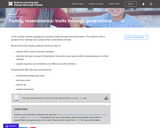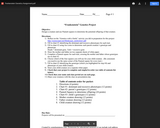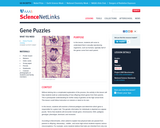
This parent guide supports parents in helping their child at home with the 7th grade Science content.
- Subject:
- Science
- Material Type:
- Reference Material
- Vocabulary
- Author:
- Kelly Rawlston
- Letoria Lewis
- Date Added:
- 10/11/2022

This parent guide supports parents in helping their child at home with the 7th grade Science content.

This resource accompanies our Rethink 7th Grade Science course. It includes ideas for use, ways to support exceptional children, ways to extend learning, digital resources and tools, tips for supporting English Language Learners and students with visual and hearing impairments. There are also ideas for offline learning.

This activity presents a fun, collaborative and interdisciplinary way to get students excited about the study of human genetics. Students pair up to create a genetic portrait of their imaginary family based on several observable, heritable traits. By actively using their knowledge, students will appreciate the importance and meaning of the study of genetics in its real-life context.

This worksheet assesses student understanding of basic genetics and patterns of heredity.

This worksheet assesses student understanding of basic genetics and patterns of heredity.

Students "breed" baby dragons using paper chromosomes to determine the genotype and phenotype.

Students build a family of styrofoam animals to model basic principles of inheritance.

Students investigate the probability of people who can/cannot curl their tongues. Students record data, conduct experiments and can trace the trait in their own families as they examine the concept of genetic traits. Use and practice of Punnett Squares as well as extension/remediation activities offer options to tailor instruction to students' learning levels.

In this lesson, students learn how to differentiate between dominant and recessive traits and genotypes. They will use this knowledge to construct a model creature, identifying its traits, and specifying which traits are dominant. Students will then predict the possible outcomes of genetic crosses between "parent" creatures.

In this lesson, students examine a case study of a woman with a family history of diabetes and create a family health portrait that will assess her risk of developing type 2 diabetes. Using the family health portrait to record the woman's family history, students identify her genetic, behavioral, and environmental risk factors for type 2 diabetes and make recommendations for lifestyle changes.

In this video module, students learn how scientists use genetic information from dogs to find out which gene (out of all 20,000 dog genes) is associated with any specific trait or disease of interest. This method involves comparing hundreds of dogs with the trait to hundreds of dogs not displaying the trait, and examining which position on the dog DNA is correlated with the trait (i.e. has one DNA sequence in dogs with the trait but another DNA sequence in dogs not displaying the trait). Students will also learn something about the history of dog breeds and how this history helps us find genes.

Students simulate the passing of traits through three generations. The students work in groups of four "siblings" and compare their combinations of traits.

Allow students maximum choice while applying their punnett square skills.

Students will come to understand that in sexually reproducing organisms, such as humans, typically half of the genes come from each parent. Students will examine a fictional pedigree and determine which gene is responsible for a given trait. The genetic information for individuals is depicted as a jigsaw puzzle.

A 5E inspired unit on genetics. Card SortJigsaw TextLab Scenario-Based Application activity

Students use pennies to determine the traits for a smiley face, then use Microsoft Word to create the smiley face. Faces are displayed in the classroom and students use their knowledge of genetics to answer questions about smiley faces, traits, and probability. NOTE: Teacher notes and a "Wrapping It Up" analysis activity are separate complementary resources.

This resource is a set of teacher notes to accompany the activity "Genetics with a Smile". It includes directions and tips for teachers as well as a sample smiley face.

This student worksheet, with answer key, is used to wrap up the activity "Genetics with a Smile".

This short video lesson gives an overview of Mendelian genetics. Assessment and discussion questions, as well as links to additional resources, are included.

Students will practice using Punnett Squares to determine traits of children. Students will determine genotypes and phenotypes of parents and children, use percentages to show how often certain genotypes and phenotypes will be seen in the children, and match a child with its parents based on their genotypes.